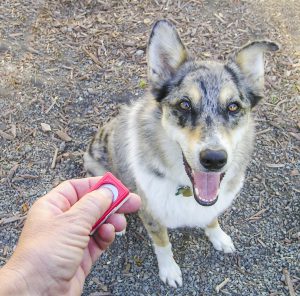Operant and Classical Conditioning
Clicker training relies on the difference between classical conditioning and operant conditioning. Classical conditioning was discovered by a guy whose name you’ll recognize—Ivan Pavlov. In classical conditioning, you form an association between a naturally existing stimulus and a neutral stimulus, so that when the neutral stimulus is present, the subject has the same response as they would to the natural stimulus. Or, in simpler terms, a bell makes you drool even when there’s no food. Operant conditioning, on the other hand, is used to create associations between behaviors and the consequences for those behaviors.
A dog moving through clicker training starts with classical conditioning. He hears a click and gets a treat. Soon, he associates the click with the reward. Then the training moves into operant conditioning, training the dog to associate repeating an action with obtaining a reward. It turns involuntary, natural behaviors into voluntary, purposeful behaviors.
Click.
Clicker training is a common training method traditionally used for animals—anyone who’s ever tried to train a puppy has heard praise for its effectiveness. It relies on principles of behavioral psychology, and marks desirable behavior with a “click,” so the animal can tell exactly when they’re performing the desired behavior.
Proponents of clicker training focus on its precision, how the clicker can provide a source of immediate, consistent feedback. The animal can tell exactly when they’re doing the right thing. The sound of the click never changes. They don’t have to decipher your body language, facial expression, tone of voice. Am I in trouble because of how my mom just said "sit," or am I about to get a treat because I did something good? They don’t hear the click during normal conversation the way they might hear words. The click only ever means one thing: you’re about to get a reward because of what you did when you heard the click.
This precise, immediate feedback is exactly why Dr. Martin Levy is using this technique to train his orthopedic surgical residents at the Bronx Montefiore Medical Center in New York.
Click.
Levy first came to the idea as a frisbee coach, when he attempted to teach himself a complicated throw. By watching himself in a mirror, he was able to discern why the placement of his hand was wrong, and then experience exactly what it felt like when the placement was correct.
It worked so well that he decided to take the technique into his day job as an orthopedic surgeon. He thought that if he could provide the same kind of “nonjudgmental, instantaneous feedback,” his students would learn faster. He decided the clicker could function like a mirror, and let his students know exactly when they had positioned their hand or instrument correctly.

Click.
By using a clicker, Levy was able to not only provide instant feedback to his residents, but also able to remove emotion from the situation. Instead of focusing on their relationship with him, their teacher—trying not to disappoint him or seeking his praise—the students focus on learning to do the task properly.
Similar to ways in which clicker training is used to break down a complex desired behavior into incremental steps so a dog can learn a complicated trick, Levy also was able to break down surgical techniques. He clicked each step when a student performed it correctly in order to more quickly teach complex techniques.
While his teaching methods remain an outlier in the world of medicine, Levy has produced measurable results through clicker training. This demonstrates that students learn techniques faster when trained with the clicker method, rather than the more traditional method.
Click.
As education continues to evolve, so do teaching methods. While clicker training wouldn’t work for all forms of teaching, and is not in use at the MSU College of Veterinary Medicine the way Levy is using it in New York, the concept of instant feedback so clearly shown in clicker training is a large part of the College’s newly reinvented curriculum.
The new curriculum follows a flipped classroom model, through which students learn material before class from reading material and lecture videos, and save class time for group work, discussion, and hands-on application. As part of the new curriculum, faculty use a tool called iClicker. iClicker allows faculty to ask the class open- and closed-ended questions, gauge student understanding, highlight points of interest on an image, and more.

Click.
In a traditional, more lecture-based curriculum, a student may learn how to perform a procedure by reading about it and watching it be performed, and then have to wait to attempt the technique themselves and receive feedback. Through the use of iClicker, faculty can assess students’ understanding of a concept instantly, ask them which steps they would take next to reach a diagnosis for a sick animal, or point out an abnormal result on a radiograph. Faculty are able to see how students in the class respond and go more in-depth to help correct faulty thinking.
Additionally, some faculty in the new curriculum have used iClicker to gather anonymous feedback from students about improvements that can be made to the courses themselves—thereby improving the quality of the learning experience for students.
Clicker-trained animals remember what they learned years after training and develop confidence in their actions, and response systems like iClicker have been proven to support increased engagement during class and improved retention. Similarly, students who learn through a flipped classroom model demonstrate increased information retention and a higher confidence in their knowledge and abilities.
Click.
